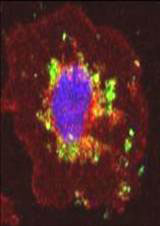| Posted: February 5, 2007 |
Can carbon nanotubes act as nanosyringes? |
|
(Nanowerk News) Researchers seeking to develop carbon nanotubes for biomedical applications have moved forward in their quest by showing that the tiny structures can effectively cross biological barriers, enabling their use in the delivery of drug therapies. Researchers at The School of Pharmacy, University of London, have shown that carbon nanotubes which have been chemically modified with a variety of different functional groups are able to enter a wide range of cell types, including human cancer cells.
|
|
The multinational research team, led by Dr Kostas Kostarelos, Deputy Head of the Centre for Drug Delivery Research at The School of Pharmacy, incubated a variety of functionalized carbon nanotubes with a range of live cells, including mammalian, bacterial and fungal cells. Their study showed that the various types of nanotubes exhibited a capacity for cellular uptake and cross-intracellular movement without causing cell death.
|
 |
| Cells analysed by epifluorescence microscopy and flow cytometry show that carbon nanotubes have been internalized. (Image: University of London, The School of Pharmacy)
|
|
Dr Kostarelos said, “The nanotubes moved through the cells as individual nanotubes or as small bundles, even under conditions that inhibit endocytosis. Nanotubes capable to act as cell-penetrating materials will have tremendous advantages” He added, “The potential of functionalized carbon nanotubes to act as nanoneedles that pierce plasma membranes and translocate directly into cytoplasm without causing cell damage or death is significant for a variety of biomedical and biotechnology applications.”
|
|
The team’s next step is to investigate further how the carbon nanotubes interact with specific cell types to determine the exact mechanisms that lead to their ‘nanoneedle’ behaviour and correlate that with toxicity studies.
|
|
The study, published online in Nature Nanotechnology, was carried out in collaboration with colleagues at the CNRS Laboratory of Immunology & Therapeutic Chemistry in Strasbourg, France and the University of Trieste in Italy.
|

